Totality Day
Monday, August 21

Eclipse Day Sunrise
Pre-dawn, Monday, August 21. Eclipse Day. I poked my head out of the tent and was relieved to see a clear display of stars. The high-level wisps from yesterday were gone. Feeling slightly unsettled by our sleep at this high altitude, I got up a bit early and wandered around our camp, taking long-exposure shots of the beautiful scenery. The air up here was crisp and clear and there wasn't a hint of a breeze. Completely... calm.

The Dragonspine
Although in general I like mountains and mountaintops, there was another reason for my desire to view the eclipse atop a peak: I had wanted to have a good view towards the western and eastern horizons, in order to perhaps get a glimpse of the racing shadow of the moon approaching and departing. Looking down into the valleys, though, I realized there might be another advantage: a thick smoky haze had settled into the lower elevations. It topped out at about 9000 feet, however, and we were well above that, in a much clearer zone, and more favorable to eclipse watching. Also, looking down on it was cool. Dragonback-like tops of ridges poked out of the pinkish murk.
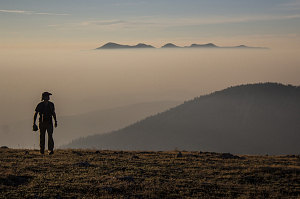
courtesy JInnes
The rest of our crew awoke roughly with sunrise, shortly before 7 a.m. We were in no particular hurry, because we were already well-positioned. The beginning of the partial phase of the eclipse wasn't due to start until after 10 a.m., and we were only 1km (0.6 miles) and 500 feet below our eclipse viewing location. Even providing for plenty of time for pre-eclipse camera gear setup, we didn't need to arrive there before 9 a.m., and it would take us maybe 30 or 40 minutes (at most) to make the hike/climb.

Ready to go
After an un-rushed breakfast, we packed up for the big event. Our packs were substantially lighter than the day before, with no camp gear and only a couple of litres of water. We began walking towards our un-named 10,850-foot highpoint, rising steeply before us just over half a mile away. A beautiful still and clear morning had developed (at least for us at this altitude - the depths of the valleys still looked smoky and murky).
On the flat ground of Railroad Ridge, it took us only ten minutes to reach the base of the summit bump. The final slope up to the top looked quite steep and challenging from our front-on view, but as is often the case with this sort of thing, as we reached the base, it became clear that this would be a rather simple (but still steep) hike up. A reasonably discernable trail wound its way up through some boulders and scree.

To the top
We wondered if many of the off-roader types camped up on Railroad Ridge would also be viewing the eclipse on this summit. After all, for them the entire sum of hiking would be a trivial less-than-one-mile hike. But as we climbed up, we encountered very few people - and the few we did encounter were simply up on top for a morning hike and were now heading back down to their vehicles. We arrived at the top - an elongated, gentle crest, and saw no one. Wait... no, there was one individual, sitting at the far southern edge of the crest and appearing to be engaged in solitary zen with nature.
Looking down on Railroad Ridge
The solitary individual had surely picked an excellent spot for meditation, for the view from the southern end of the crest was magnificent. Back on Railroad Ridge, we had been at the northern end of the White Cloud Mountains, with views to the south and the heart of the range blocked by our un-named summit. Up here on top of said summit, though, we had a commanding view south into the Big Boulder Lakes basin and the heart of the White Clouds: sharp high peaks with jewel-like tarns nestled beneath them.
We had arrived with plenty of time to burn (it was only 8 a.m. at this point), so I wandered to the southern edge and took some wide-angle photos, and introduced myself to said individual, apologizing for disturbing his peace. Charles was his name, an Idaho local. He didn't mind the intrusion at all, noting that if there was ever going to be a day in the White Clouds where one probably shouldn't expect a solitary experience, it would be this day. Apparently he was more of a river-runner sort of outdoorsperson, but for today, the place to be for him was high in the mountains watching this awesome event.
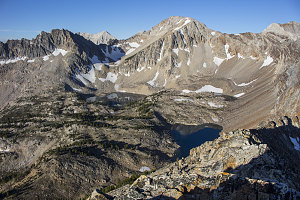
courtesy JInnes
High above Railroad Ridge
Gunsight and Tin Cup Lakes
After taking in the fabulous view and chatting with Charles, we walked back north for a minute or so and picked a relatively flat spot for our eclipse viewing experience. I wanted a spot that would allow me to set up a wide-angle shot that would encompass the ground, us, and the eclipse, so we picked something close to summit's edge. This allowed me to place a tripod slightly below us, looking back up.
After a good 45 minutes of lounging around and enjoying our awesome, secluded perch, it was time to setup the gear. And a fair bit of gear we had, too - no less than five tripods and six cameras in total, along with binoculars and filters and shutter releases and other assorted things.
I had thought about how to capture the eclipse without losing ourselves (and myself in particular) in the nitty-gritty of managing gear, deciding on and configuring settings, and in general being distracted from experiencing this brief but wonderful event that is called totality.

courtesy JInnes
No less than five tripods were set up: one DSLR with a 400mm zoom to capture closeups of the sun and moon, one DSLR with a 16mm wide angle to capture us, the horizon, the sky, and the sun, one set of binoculars (with solar filters, of course), one Go-Pro (to capture a time lapse), and - just before during and after totality, another DSLR to capture full video of us experiencing the event. Lotta hardware, lotta configuration. This much gear was too much for one person to handle all at once, so I assigned myself the two main cameras and divvied up the remaining gear amongst everyone else. Each of us had at least one responsibiity. Would we get it all right or bungle it completely?

courtesy JInnes
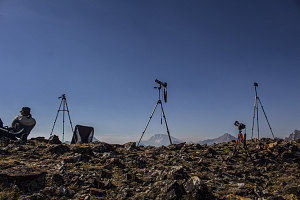
courtesy JInnes
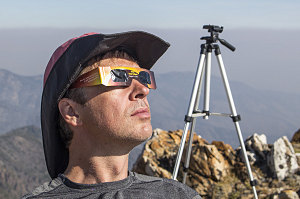
courtesy JInnes
We were set up and ready by about 9:30 a.m., comfortably ahead of eclipse start time. I had forgotten to write down the time of first contact, when the moon would first start to obscure the sun. It was of little concern, since it would soon be obvious that the eclipse was starting. But the not knowing precisely made the time drag, and drag and drag. The wait seemed agonizingly long - the complete inverse of how the short period of totality would feel, I was sure.
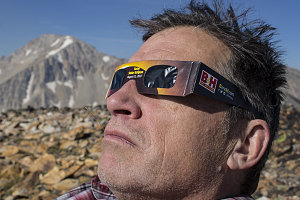
courtesy JInnes
Official Eclipse Glasses
We tested the gear. Tried out our eclipse glasses. Chatted with nearby summit neighbour Charles. Welcomed a small party of three and their friendly (but untethered) dog as they made their way to another corner of the summit area. Admired the amazing twisted metamorphic geology of the nearby peaks. Then, finally - after staring and staring - we noticed a little thumbnail carved out of the upper-right of the sun's disc. Heartbeat skip time: For us, finally, The Great American Eclipse had started!!

courtesy PChen
The pace of events started off slow, like a waltz that slowly increases its tempo. We had over an hour before the start of totality.
I started off with my photo sequences - completely automatically with my wide angle and initiated with a remote shuttle release on my "zoom" camera. Brian had started up the GoPro's time lapse sequence. Pu and Jenn captured us... capturing it all. It all sounds complicated as I describe it, but with the advance configuration and written notes, we didn't have to exert much thought at all - point and click and done.
One important thing about the configuration of my auto-sequence wide angle camera: I had set its settings in full manual mode. Because of this, the camera would not attempt to compensate for the dimming of light as the eclipse progressed. Human eyes and auto cameras are good at hiding the changes in light, but the way I had set up this camera, we'd get an accurate record of how dark it would get between eclipse start and totality. Take note of the sequence of wide angle shots below, and you'll see just how much the light changed. Very dramatically.

courtesy JInnes
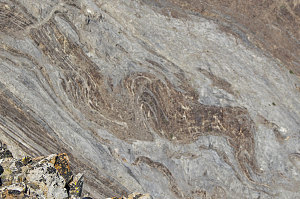
courtesy JInnes
10:57 a.m. Things seem pretty normal
Both slowly - and surprisngly quickly - depending on how you thought about it - the bizarre black disc of the moon slid across the sun's face. The sense of celestial mechanics became palpable as we watched: us spinning to the left on the surface of a globe, all the while the moon racing in its orbit eastward, even faster than our rotation, perfectly obscuring the sun. Four hundred times closer but four hundred times smaller, it was just perfectly tracking to cover the sun. Thrilling.
11:11 a.m. Starting to darken
11:19 a.m. major darkening now
Up until about 50 or 60% coverage, it was very hard to discern any sort of light reduction simply by looking around. The quality of light perhaps seemed a bit strange, with some slight changes in color and contrast, but mostly, you wouldn't notice if you didn't know (a consequence of our eyes' amazing dynamic range and low-light sensitivity).
We created little mini camera obscuras with our hands, making little openings with a fist and projecting light through them onto the rock, where we could see little crescent representations of the eclipse. Cool.
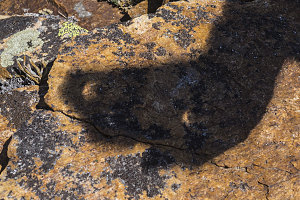
courtesy PChen
11:22 a.m. Six minutes from totality
Twenty minutes past 11 a.m. - less than ten minutes before totality - things started getting intense. The light fall-off was really starting to get noticeable now, and all around us, the mountains looked simultaneously dim and yet incredibly crisp. We knew an incredible thing - a pocket of nighttime - was racing our way from the west at more than 3000 km/hr. Almost, almost here! How would it feel?
Well, cold, for one - the temperature had dropped noticeably as the sun became more than half-covered, and we eventually put on several layers to keep us warm. Fortunately, apart from one brief gust of a breeze, it was completely calm and still up here at 10,800 feet. The land had paused, waiting for totality.
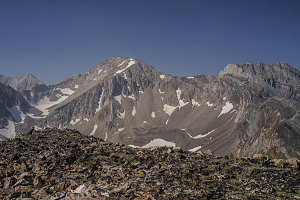
courtesy PChen
Faster and faster, time seemed to pass. Above us, the sun still looked to the unfiltered eye as a brilliant object - but now more like a really bright star than a "sun". With the filters, it was an incredibly, incredibly thin crescent. We let out some muted whoops as we sank into the well of the moon's shadow. And look - look at this next picture and see how dark it had become. Remember, this is the exact same setting that produced a bright normal daytime scene just an hour before. Now it shows nearly complete night.
11:28 a.m. Seconds before totality!
Then... the transformation. In the space of a second or two, the sun above us smoothly transformed from an angry bright star to a... to a... thing. A hole in space. A profoundly black, perfect, inky hole. And surrounding that hole, a silvery angelic light had sprung into view. It was a solid ring directly around the hole but with graceful tendrils fading and streaming away in brush strokes away in all directions: the solar corona.
Totality.
Trembling with awe and excitement, I quickly flipped my main camera into 'totality' mode and fired off several bracketed shots. I also changed my wide-angle camera's manual setting so that we could better expose to see the beautiful sky effects: black and nighttime above, complete with planets and stars, and all around on the horizon - sunset (or... sunrise?) - in all directions. A full 360 degrees of twilight colors.